Microstructure Formation of Functional Polymers by Evaporative Self-Assembly under Flexible Geometric Confinement
Abstract
:1. Introduction
2. Materials and Methods
2.1. Materials
2.2. Experimental Process
2.3. FET Device Fabrication Based on RR-P3HT
2.4. Characterization
3. Results and Discussion
3.1. Formation of the Flexible Geometric Confinement
3.2. Effect of Evaporative Openning on the Patterning of PMMA Microstructure
3.3. Patterning of RR-P3HT Microstructures
4. Conclusions
Supplementary Materials
Acknowledgments
Author Contributions
Conflicts of Interest
References
- Xu, J.; Xia, J.; Hong, S.W.; Lin, Z.; Qiu, F.; Yang, Y. Self-assembly of gradient concentric rings via solvent evaporation from a capillary bridge. Phys. Rev. Lett. 2006, 96, 066104. [Google Scholar] [CrossRef] [PubMed]
- Han, W.; Lin, Z.Q. Learning from “Coffee Rings”: Ordered Structures Enabled by Controlled Evaporative Self-Assembly. Angew. Chem. Int. Ed. 2012, 51, 1534–1546. [Google Scholar] [CrossRef] [PubMed]
- Byun, M.; Bowden, N.B.; Lin, Z. Hierarchically organized structures engineered from controlled evaporative self-assembly. Nano Lett. 2010, 10, 3111–3117. [Google Scholar] [CrossRef] [PubMed]
- Han, W.; Byun, M.; Lin, Z. Assembling and positioning latex nanoparticles via controlled evaporative self-assembly. J. Mater. Chem. 2011, 21, 16968–16972. [Google Scholar] [CrossRef]
- Mei, J.; Diao, Y.; Appleton, A.L.; Fang, L.; Bao, Z. Integrated materials design of organic semiconductors for field-effect transistors. J. Am. Chem. Soc. 2013, 135, 6724–6746. [Google Scholar] [CrossRef] [PubMed]
- Shimoni, A.; Azoubel, S.; Magdassi, S. Inkjet printing of flexible high-performance carbon nanotube transparent conductive films by “coffee ring effect”. Nanoscale 2014, 6, 11084–11089. [Google Scholar] [CrossRef] [PubMed]
- Tortorich, R.P.; Choi, J.W. Inkjet Printing of Carbon Nanotubes. Nanomaterials 2013, 3, 453–468. [Google Scholar] [CrossRef] [PubMed]
- Ishikawa, F.N.; Chang, H.K.; Ryu, K.; Chen, P.C.; Badmaev, A.; Gomez De Arco, L.; Shen, G.; Zhou, C. Transparent electronics based on transfer printed aligned carbon nanotubes on rigid and flexible substrates. ACS Nano 2009, 3, 73–79. [Google Scholar] [CrossRef] [PubMed]
- Oh, J.Y.; Shin, M.; Lee, T.I.; Jang, W.S.; Lee, Y.-J.; Kim, C.S.; Kang, J.-W.; Myoung, J.-M.; Baik, H.K.; Jeong, U. Highly Bendable Large-Area Printed Bulk Heterojunction Film Prepared by the Self-Seeded Growth of Poly(3-hexylthiophene) Nanofibrils. Macromolecules 2013, 46, 3534–3543. [Google Scholar] [CrossRef]
- Xu, J.; Wang, J.; Mitchell, M.; Mukherjee, P.; Jeffries-El, M.; Petrich, J.W.; Lin, Z. Organic-inorganic nanocomposites via directly grafting conjugated polymers onto quantum dots. J. Am. Chem. Soc. 2007, 129, 12828–12833. [Google Scholar] [CrossRef] [PubMed]
- Park, W.K.; Kim, T.; Kim, H.; Kim, Y.; Tung, T.T.; Lin, Z.; Jang, A.R.; Shin, H.S.; Han, J.H.; Yoon, D.H.; Yang, W.S. Large-scale patterning by the roll-based evaporation-induced self-assembly. J. Mater. Chem. 2012, 22, 22844–22847. [Google Scholar] [CrossRef]
- Lin, Z.; Granick, S. Patterns formed by droplet evaporation from a restricted geometry. J. Am. Chem. Soc. 2005, 127, 2816–2817. [Google Scholar] [CrossRef] [PubMed]
- Li, X.; Wang, C.; Shao, J.; Ding, Y.; Tian, H.; Li, X.; Wang, L. Periodic parallel array of nanopillars and nanoholes resulting from colloidal stripes patterned by geometrically confined evaporative self-assembly for unique anisotropic wetting. ACS Appl. Mater. Interfaces 2014, 6, 20300–20308. [Google Scholar] [CrossRef] [PubMed]
- Powroźnik, P.; Stolarczyk, A.; Wrotniak, J.; Jakubik, W. Study of Poly(3-hexyltiophene) Polymer Sensing Properties in Nerve Agent Simulant (DMMP) Detection. Proceedings 2017, 1, 448. [Google Scholar] [CrossRef]
- Wang, Y.; Lieberman, M.; Hang, Q.; Bernstein, G. Selective binding, self-assembly and nanopatterning of the Creutz-Taube ion on surfaces. Int. J. Mol. Sci. 2009, 10, 533–558. [Google Scholar] [CrossRef] [PubMed]
- Smith, M.K.; Singh, V.; Kalaitzidou, K.; Cola, B.A. Poly(3-hexylthiophene) nanotube array surfaces with tunable wetting and contact thermal energy transport. ACS Nano 2015, 9, 1080–1088. [Google Scholar] [CrossRef] [PubMed]
- Ting, Y.-H.; Liu, C.-C.; Park, S.-M.; Jiang, H.; Nealey, P.F.; Wendt, A.E. Surface Roughening of Polystyrene and Poly(methyl methacrylate) in Ar/O2 Plasma Etching. Polymers 2010, 2, 649–663. [Google Scholar] [CrossRef]
- Singh, S.; Vardeny, Z.V. Ultrafast Transient Spectroscopy of Polymer/Fullerene Blends for Organic Photovoltaic Applications. Materials 2013, 6, 897–910. [Google Scholar] [CrossRef] [PubMed]
- Sun, W.; Yang, F.Q. Self-Organization of Unconventional Gradient Concentric Rings on Precast PMMA Films. J. Phys. Chem. C 2014, 118, 10177–10182. [Google Scholar] [CrossRef]
- Wang, H.; Xu, Y.; Yu, X.; Xing, R.; Liu, J.; Han, Y. Structure and Morphology Control in Thin Films of Conjugated Polymers for an Improved Charge Transport. Polymers 2013, 5, 1272–1324. [Google Scholar] [CrossRef]
- Kakogianni, S.; Andreopoulou, A.; Kallitsis, J. Synthesis of Polythiophene–Fullerene Hybrid Additives as Potential Compatibilizers of BHJ Active Layers. Polymers 2016, 8, 440. [Google Scholar] [CrossRef]
- Gao, X.; Han, Y.-C. P3HT stripe structure with oriented nanofibrils enabled by controlled inclining evaporation. Chin. J. Polym. Sci. 2013, 31, 610–619. [Google Scholar] [CrossRef]
- Sun, Y.; Han, Y.; Liu, J. Controlling PCBM aggregation in P3HT/PCBM film by a selective solvent vapor annealing. Chin. Sci. Bull. 2013, 58, 2767–2774. [Google Scholar] [CrossRef]
- Wang, K.; Li, X.; Wang, C.; Qian, M.; Ding, G.; Liu, J. Vapor-assisted room temperature nanoimprinting-induced molecular alignment in patterned poly(3-hexylthiophene) nanogratings and its stability during thermal annealing. RSC Adv. 2017, 7, 40208–40217. [Google Scholar] [CrossRef]
- Sun, Y.; Lin, Y.; Su, Z.; Wang, Q. One-step assembly of multi-layered structures with orthogonally oriented stripe-like patterns on the surface of a capillary tube. Phys. Chem. Chem. Phys. 2017, 19, 23719–23722. [Google Scholar] [CrossRef] [PubMed]
- Leite, G.V.; Van Etten, E.A.; Forte, M.M.C.; Boudinov, H. Degradation of current due to charge transport in top gated P3HT—PVA organic field effect transistors. Synth. Met. 2017, 229, 33–38. [Google Scholar] [CrossRef]
- Gao, X.; Xing, R.-B.; Liu, J.-G.; Han, Y.-C. Uniaxial alignment of poly(3-hexylthiophene) nanofibers by zone-casting approach. Chin. J. Polym. Sci. 2013, 31, 748–759. [Google Scholar] [CrossRef]
- Li, W.; Lan, D.; Wang, Y. Dewetting-mediated pattern formation inside the coffee ring. Phys. Rev. E 2017, 95, 042607. [Google Scholar] [CrossRef] [PubMed]
- Deegan, R.D.; Bakajin, O.; Dupont, T.F.; Huber, G.; Nagel, S.R.; Witten, T.A. Capillary flow as the cause of ring stains from dried liquid drops. Nature 1997, 389, 827–829. [Google Scholar] [CrossRef]
- Ristenpart, W.D.; Kim, P.G.; Domingues, C.; Wan, J.; Stone, H.A. Influence of substrate conductivity on circulation reversal in evaporating drops. Phys. Rev. Lett. 2007, 99, 234502. [Google Scholar] [CrossRef] [PubMed]
- Hu, H.; Larson, R.G. Marangoni effect reverses coffee-ring depositions. J. Phys. Chem. B 2006, 110, 7090–7094. [Google Scholar] [CrossRef] [PubMed]
- Zhao, K.; Xue, L.; Liu, J.; Gao, X.; Wu, S.; Han, Y.; Geng, Y. A new method to improve poly(3-hexyl thiophene) (P3HT) crystalline behavior: decreasing chains entanglement to promote order-disorder transformation in solution. Langmuir 2010, 26, 471–477. [Google Scholar] [CrossRef] [PubMed]
- Oh, J.Y.; Shin, M.; Lee, T.I.; Jang, W.S.; Min, Y.; Myoung, J.-M.; Baik, H.K.; Jeong, U. Self-Seeded Growth of Poly(3-hexylthiophene) (P3HT) Nanofibrils by a Cycle of Cooling and Heating in Solutions. Macromolecules 2012, 45, 7504–7513. [Google Scholar] [CrossRef]
- He, M.; Li, B.; Cui, X.; Jiang, B.; He, Y.; Chen, Y.; O’Neil, D.; Szymanski, P.; Ei-Sayed, M.A.; Huang, J.; Lin, Z. Meniscus-assisted solution printing of large-grained perovskite films for high-efficiency solar cells. Nat. Commun. 2017, 8, 16045. [Google Scholar] [CrossRef] [PubMed]
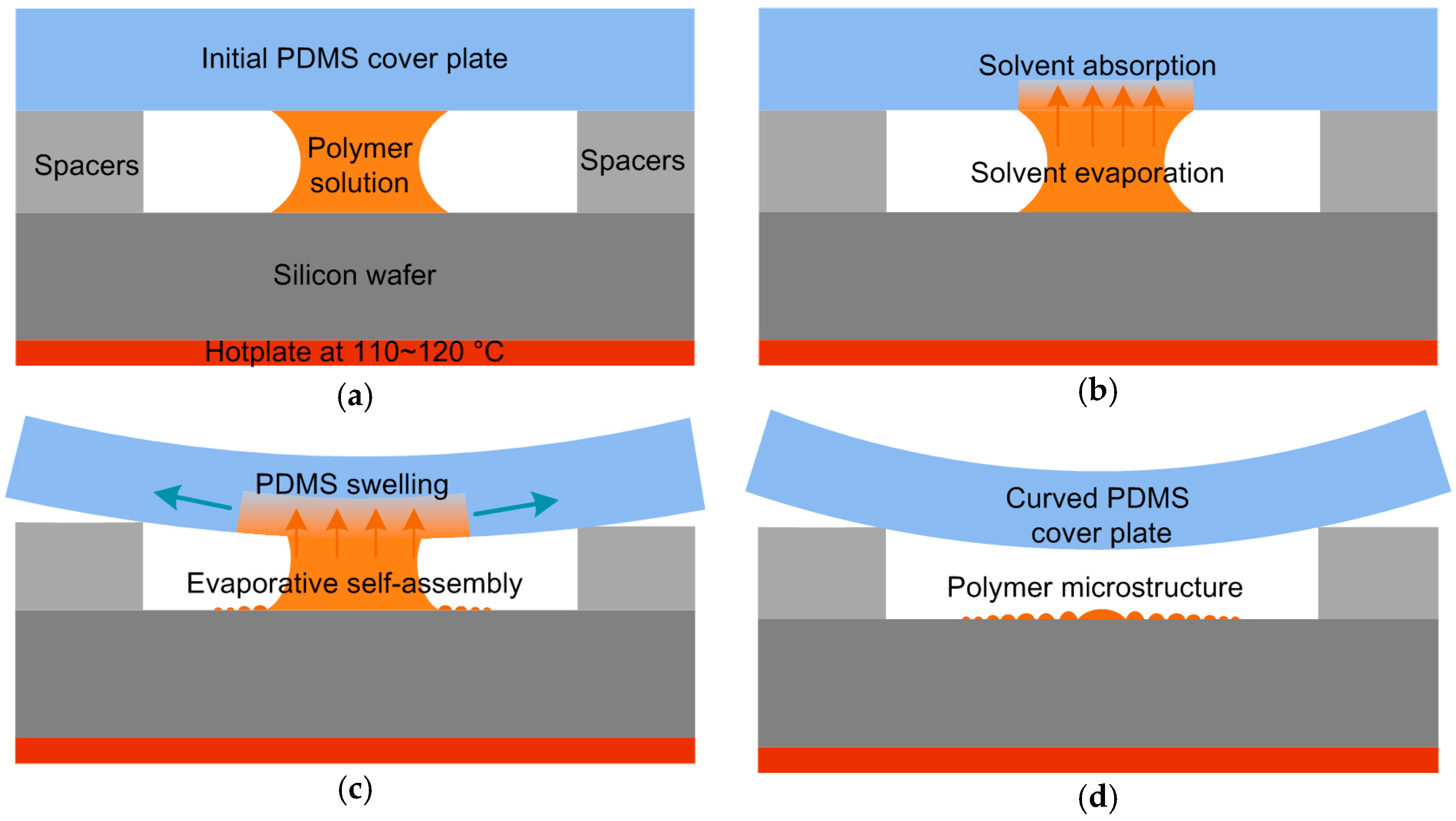
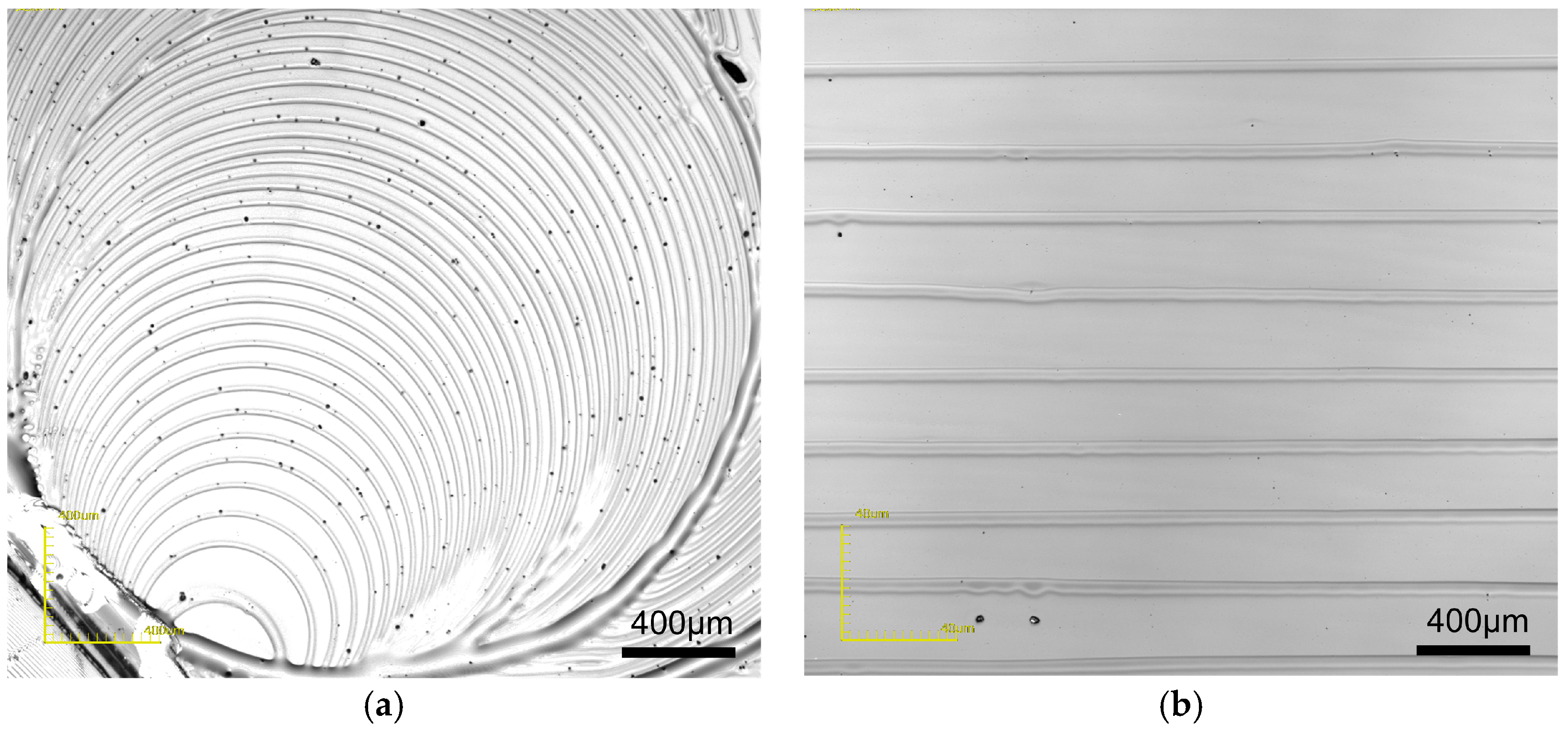
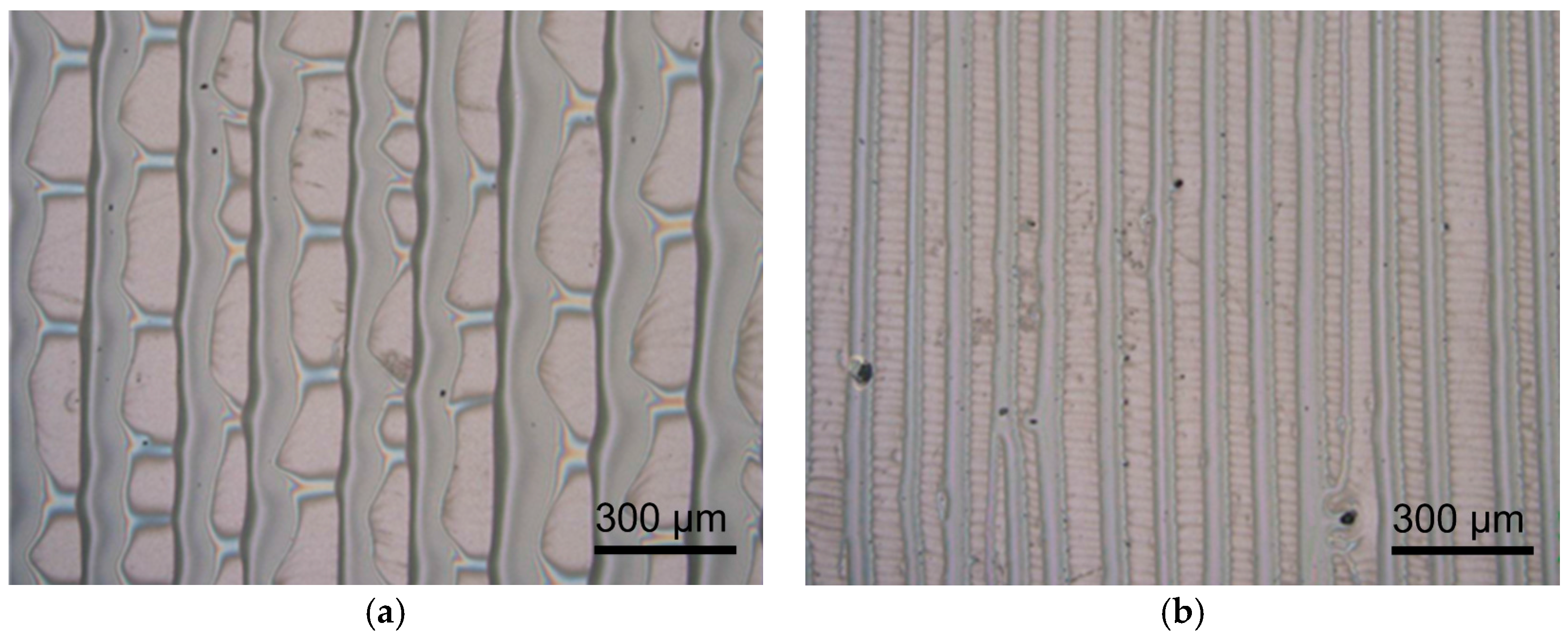


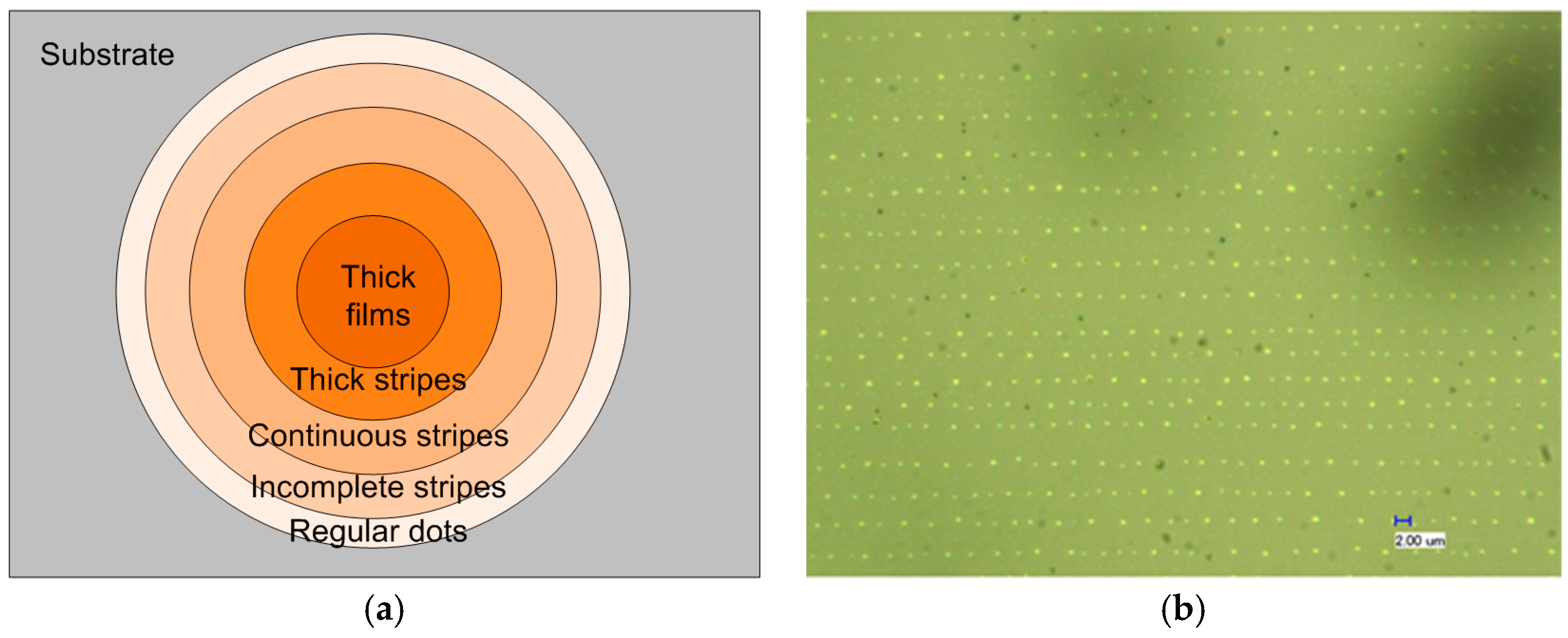

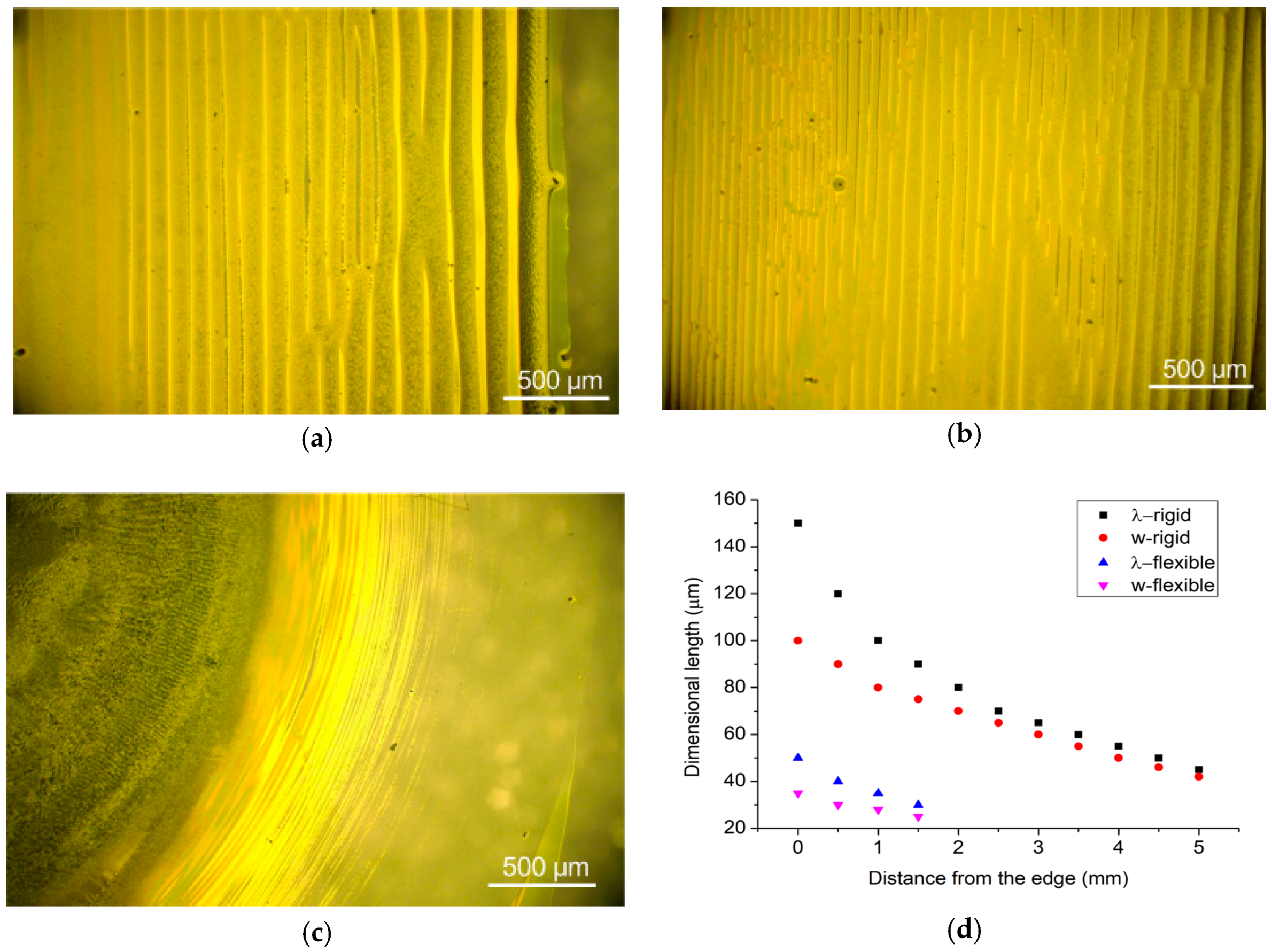
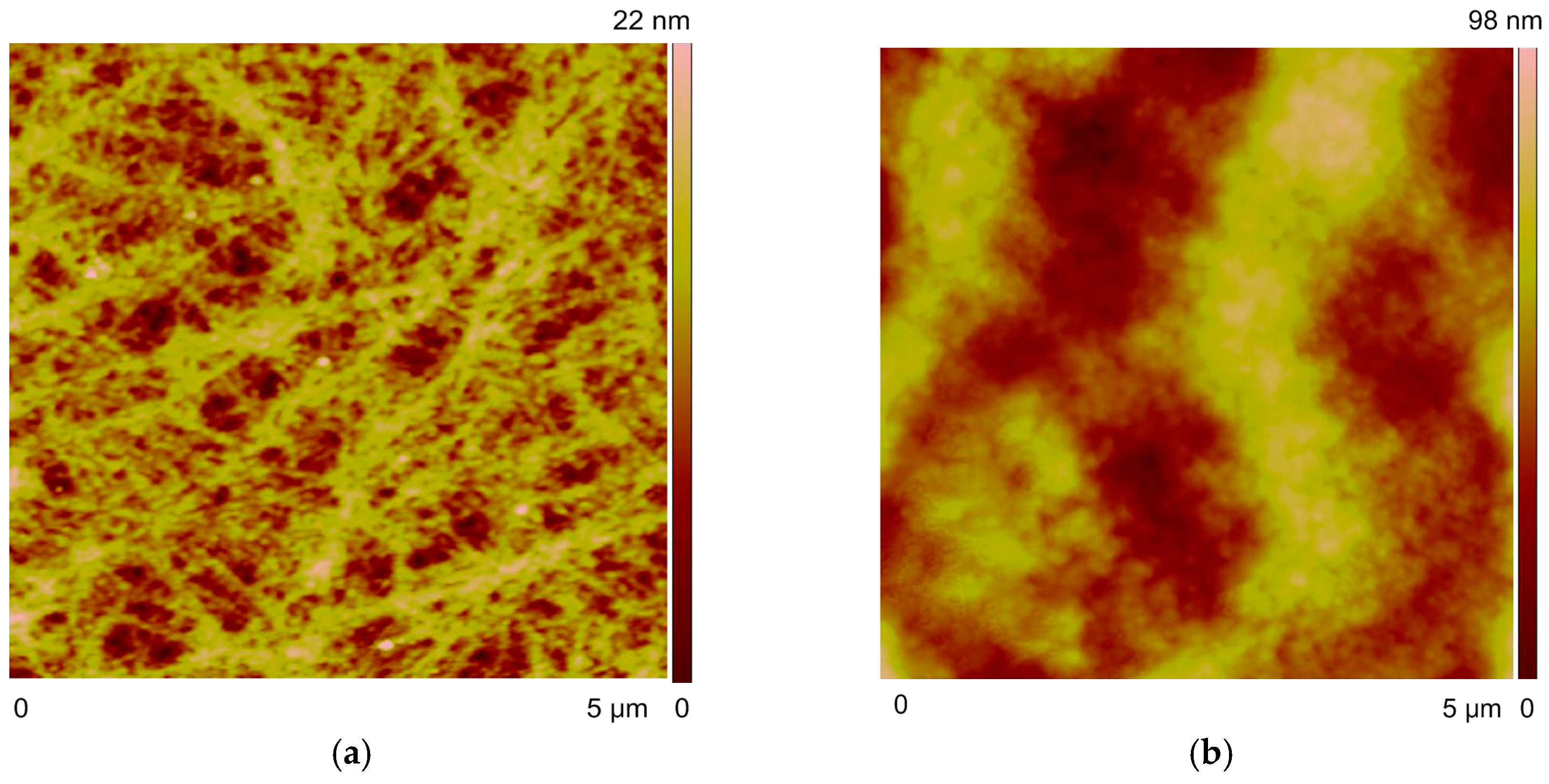
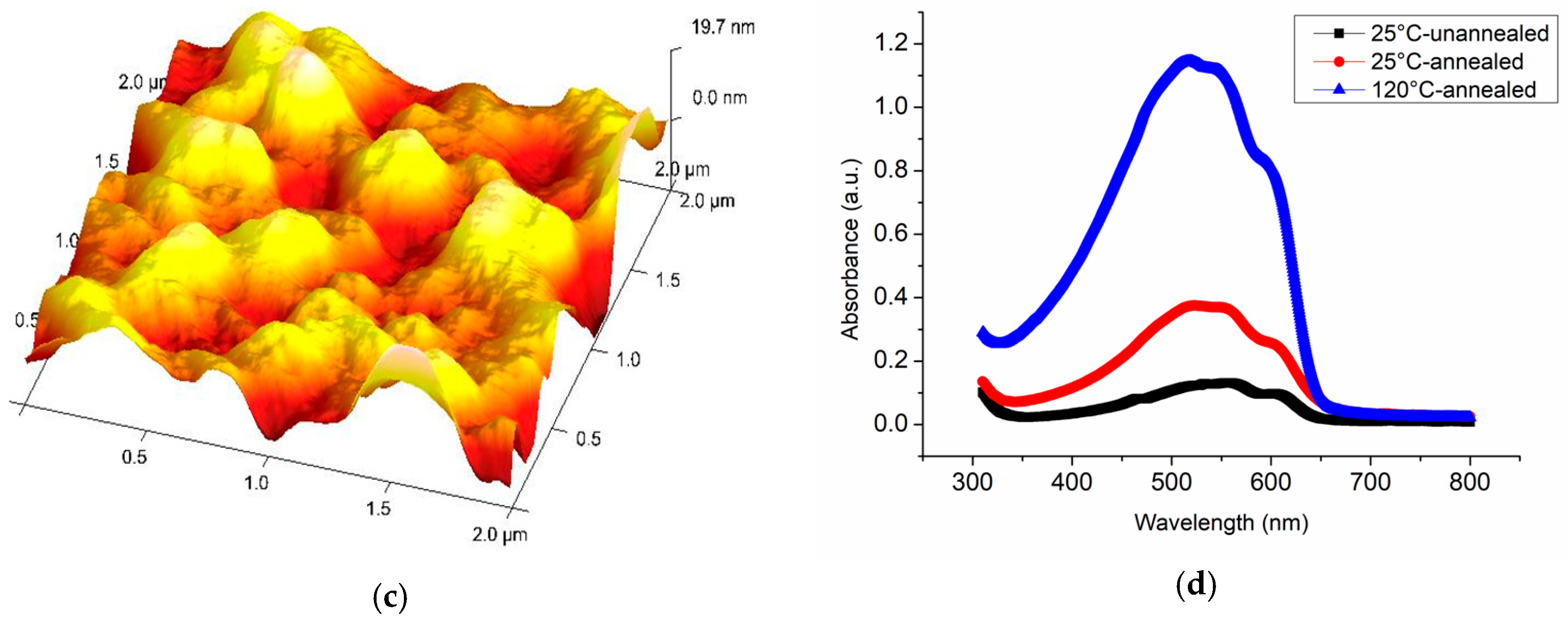
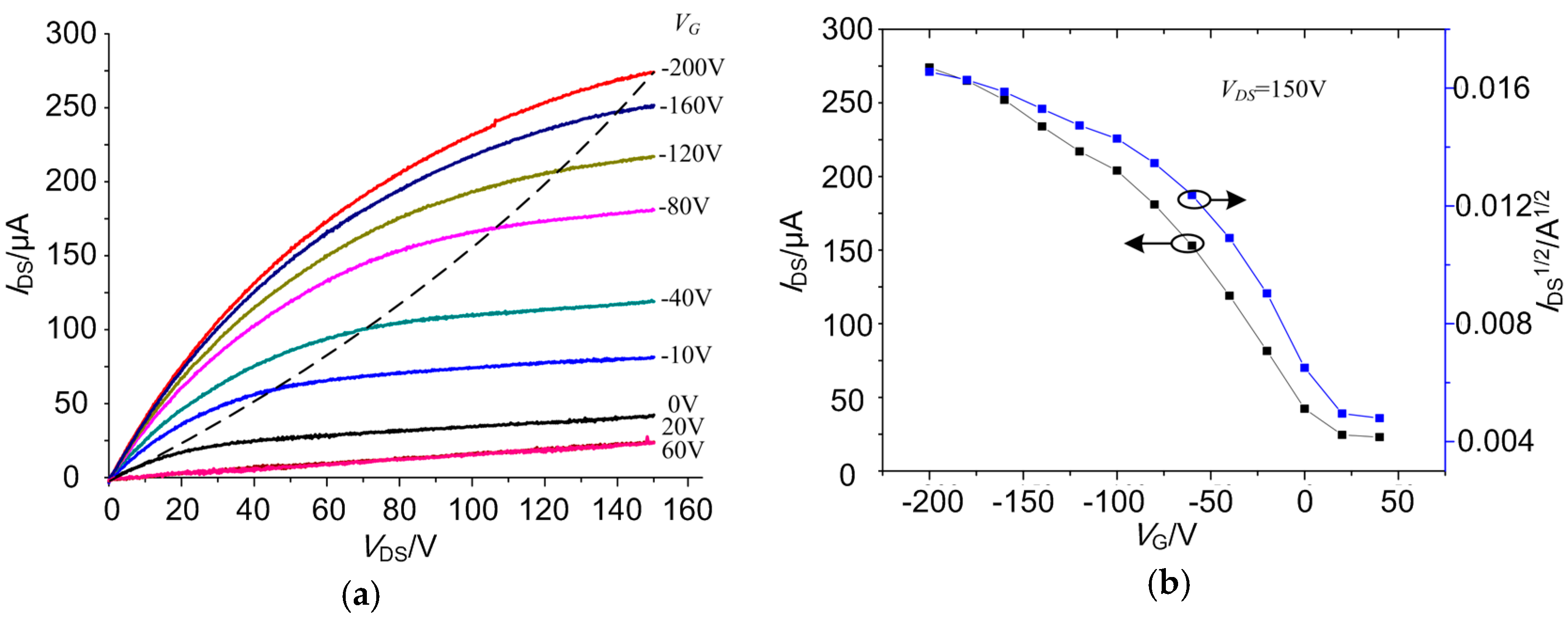
| Gap Height/μm | Vertical Periodicity/μm | Vertical Width/μm | Lateral Periodicity/μm | Lateral Width/μm |
|---|---|---|---|---|
| 250 | 80 | 35 | 25 | 3 |
| 500 | 100 | 45 | 120 | 20 |
| 1000 | 250 | 125 | 300 | 60 |
| Distance/mm | Width/μm | Periodicity/μm |
|---|---|---|
| 1 | 6 | 60 |
| 2 | 2.5 | 42 |
| 3 | 1 | 18 |
| 4 | 0.6 | 9 |
| μ (cm2/Vs) | Vth (V) | Ion/Ioff |
|---|---|---|
| ~0.01 | ~25 | <102 |
© 2018 by the authors. Licensee MDPI, Basel, Switzerland. This article is an open access article distributed under the terms and conditions of the Creative Commons Attribution (CC BY) license (http://creativecommons.org/licenses/by/4.0/).
Share and Cite
Li, X.; Zhu, X.; Wei, H. Microstructure Formation of Functional Polymers by Evaporative Self-Assembly under Flexible Geometric Confinement. Micromachines 2018, 9, 124. https://doi.org/10.3390/mi9030124
Li X, Zhu X, Wei H. Microstructure Formation of Functional Polymers by Evaporative Self-Assembly under Flexible Geometric Confinement. Micromachines. 2018; 9(3):124. https://doi.org/10.3390/mi9030124
Chicago/Turabian StyleLi, Xiangmeng, Xijing Zhu, and Huifen Wei. 2018. "Microstructure Formation of Functional Polymers by Evaporative Self-Assembly under Flexible Geometric Confinement" Micromachines 9, no. 3: 124. https://doi.org/10.3390/mi9030124





